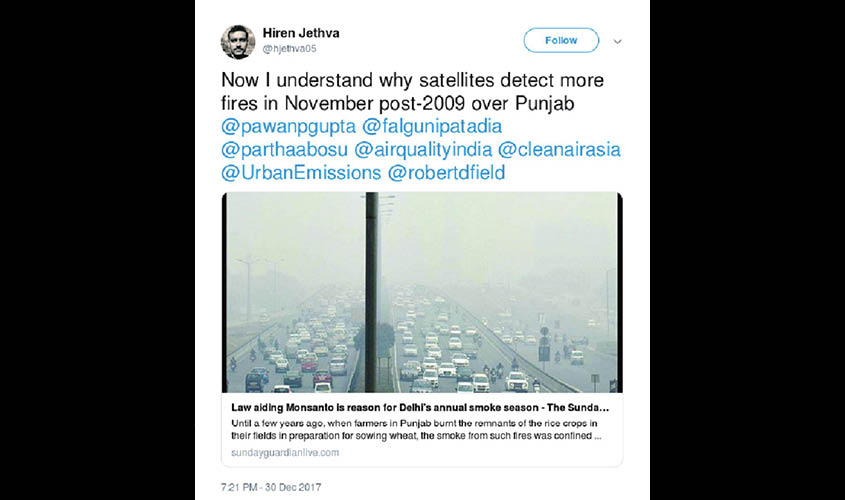In December 2017, this newspaper exposed in an article entitled “Law aiding Monsanto is reason for Delhi’s smoke season” how a law to help Monsanto was the reason for the Delhi metropolitan region being blanketed in smoke every November. That law, the Punjab Preservation of Subsoil Water Act of 2009, imposed a delay on farmers who wanted to plant rice. The delay in planting in turn created a delay in harvesting and clearing the land. Farmers burned their land to clear their field and the delay in this process meant that the smoke would now travel all the way to Delhi, which was not the case in earlier decades. Instead of targeting Hindu festivals like Diwali and banning fireworks during the festival, the government and the courts need to get to the real reason and fix it.
The reason for the smoke travelling to Delhi being a recent phenomenon is that the direction of the wind during the monsoon season blows primarily from the west into Delhi but changes in the second half of October and starts blowing from the north. When farmers burned their fields in September in earlier decades, it did not affect the Delhi region, but started impacting the capital after farmers were forced to accept the delay imposed on them.
When The Sunday Guardian published the article, Dr Hiren Jethva, an aerosol remote sensing scientist at NASA’s Goddard Space Flight Center, sent out a tweet (see image) saying, “Now I understand why satellites detect more fires in November post-2009 over Punjab.” When contacted, Dr Jethva added, “I would like to add here that the seasonal shift in peak crop fires had occurred prior during 2006-2009 in comparison to 2002-2005, as shown by the satellite data. Although Monsanto law became effective in 2009, I doubt that the delay in setting fires which already began in previous year was a reflection of the upcoming law. The seasonal shift post-2009 continued in the wake of the Monsanto law in conjunction with the increasing crop production, hence residue burning, making the air quality even worse during the last and first week of Oct and Nov.”
Dr Jethva’s message made me look for any policy changes that occurred between 2006 and 2009. It turns out that the process of applying pressure on farmers to delay planting paddy began in 2007. The proposal for a law mandating the delay was first proposed in 2006. Then, in 2007, Punjab Agriculture Minister Sucha Singh Langa stated that the Agriculture Department had been persuading farmers to delay sowing paddy and stated his goal of reducing the area of cultivation of paddy from 26.50 lakh hectares to 25.00 lakh hectares during the year, while increasing the acreage of cotton from 6.07 lakh hectares to 6.50 lakh hectares. The minister also stated that he had directed that Bt Cotton seeds be supplied to farmers at a rate fixed by the government.
The sale of Bt Cotton meant that the primary beneficiary would be the mega-corporation Monsanto, which seeks to control the world’s food supply. The push for Punjab’s law came from another source, the United States Agency for International Development (USAID), which has acted as a shill for Monsanto around the world. Then, in 2008, before the legislature acted, the Punjab government issued a government notification imposing a delay on the planting of rice. The government’s actions in 2007 and 2008 explain Dr Jethva’s observations of the satellite data.
After the previous article was published, both the Chief Ministers of Delhi and Punjab were contacted with the information about the delay in planting rice causing the phenomenon of Delhi being
At this point, the people of Delhi have two choices. They could either take to the streets and march against Monsanto and evict the corporation from India and restore the previous cropping pattern, or they can wait to get suffocated when Delhi once again becomes a gas chamber this year.

